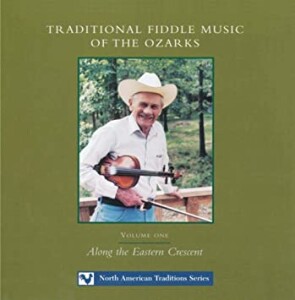 Fiddle music was once endemic to nearly every region of North America, including Mexico and certainly Canada. Most regions developed their own peculiar styles – the best known include southern Louisiana (Cajun), Texas, Appalachia, New England, and Cape Breton Island in Nova Scotia. Another region with its own style of fiddling was the Ozarks, a hilly region that takes in parts of Missouri, Arkansas and Oklahoma.
Fiddle music was once endemic to nearly every region of North America, including Mexico and certainly Canada. Most regions developed their own peculiar styles – the best known include southern Louisiana (Cajun), Texas, Appalachia, New England, and Cape Breton Island in Nova Scotia. Another region with its own style of fiddling was the Ozarks, a hilly region that takes in parts of Missouri, Arkansas and Oklahoma.
This CD is the first of a three-volume set in Rounder’s excellent North American Traditions series, focusing on the old-time fiddle music of the Ozarks. It was clearly a labor of love for producers Gordon McCaan and Mark Wilson, as well as the 10 fiddlers, most of them well beyond 70 years of age. As Wilson says in his extensive liner notes, it’s important that these regional fiddle works be recorded, because the process of homogenization is well along. The advent of records, radio and TV, as well as the greater ease of traveling in the second half of the 20th century, all have conspired to nearly kill old-time dance music played by small string bands.
Several of the fiddlers represented here have been recorded elsewhere, usually in bluegrass bands. But for this project, the producers traveled to their homes in the Ozarks and persuaded them to play some of the older tunes they know, in the old-time style, which is quite different from bluegrass. This is the kind of music you would have heard on a Saturday night up in the hills in the Twenties through the Fifties, when folks would gather at someone’s house, haul the furniture out in the yard, and play and dance ’til the rooster crowed.
All of these fiddlers are good musicians, and some are great. With a couple of them, particularly the nonagenarian Jesse Wallace, you can tell they’re old, and so are their instruments. Many of them returned to the fiddle in their “retirement” after a lifetime of work and family responsibilities. Some kept playing all their lives.
But the one thread that binds all these players and their performances is the sense of utter joy that permeates the music. When these folks rosin up their bows and tuck the fiddle under their chin, they’re as old as the hills and as young as the dew on the leaves at sunrise. The players and the music transcend time and age.
These are field recordings; and although the quality is generally very good, it does vary from track to track, or rather from player to player. In some cases, the accompanying guitar, banjo or bass comes through a little clearer than on other tracks. The occasional rhythm provided by a brushed snare drum or by a clacking jawbone (yes, jawbone – the notes don’t specify what animal it’s from) is usually way back in the mix, sometimes barely audible. Which generally is okay; these fiddlers can get your toes tapping all by themselves, thank-you-very-much.
On several tracks, particularly those by Stan Jackson, the microphone stand shudders with a thud every time one of the musicians taps his foot, but that’s generally the only real distraction on the recordings. Pretty good for field work.
It’s hard to pick a favorite from the 40 tracks on this disc, but I like Bob Holt’s performances best. He is a very fluid and expressive player, and has chosen several very nice tunes for this collection, particularly the well-known square-dance numbers “Blue Mule” and “Wolves a-Howling.”
Jesse Wallace also plays several extremely entertaining songs, including “Old Joe Redbird,” “Bay Rooster,” and “Old Leather Bonnet With a Hole in the Crown.” But Wallace tends to produce a very high-pitched squeal with his bow while he’s playing, which can be painful for sensitive ears.
The only woman fiddler on this disc is the octogenarian great-great-grandmother Violet Hensley. She plays with accompaniment from two of her daughters, performing a number of very engaging tunes, including “Sam Moore Waltz” and “Mate to the Hog Waltz,” which is actually a reel. Her playing has a definite old-time sound, with many notes sounding flatter than you’d hear in bluegrass or other styles.
Howe Teague plays many of his pieces in “dischord” tunings, rather than the standard keys. His playing is very clean and warm, and the production of his songs is some of the best on the disc, with all the sounds coming through very clearly. His “Wabash Foxtrot” is an excellent piece, with a touch of a ragtime feel to it.
It’s fun to listen to these songs for the various influences the fiddlers incorporate. I’m hardly an expert at fiddle music, but even I can often hear Celtic or Scottish antecedents in some of these tunes, as well as the ghost of “Turkey in the Straw” and other folk songs.
Fiddle players, students and fans have reason to rejoice: Traditional Fiddle Music of the Ozarks is a treasure.
(Rounder, 1999)
